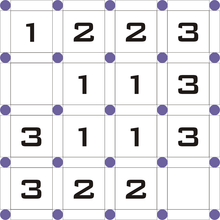Suriza
Suriza ( Japanese ス リ ザ ー リ ン ク surizā rinku , English slither link ) is a puzzle that was first published by the Japanese magazine Nikoli .
Suriza is also known by other names, including serpentine, slitherlink, holy path, circular path, garden fence, fences and number line .
regulate
Suriza is played on a square grid . The grid points and the edges are usually marked or highlighted. The aim is to draw a closed path without intersections and branches made of edges between the points of the grid. In some squares there are numbers between 0 and 3, which indicate how many edges of the path must adjoin this field. Unmarked fields can contain any number from 0 to 3 and thus any number of edges of the path can be adjacent to these fields.
Normally, the solution or the path sought is clearly defined by the given numbers.
Solution strategy
To solve a suriza, one typically first tries to determine small fragments of the path sought, which can then be gradually connected to form larger sections. For example, there must be a piece of the path you are looking for between two fields that both contain a three. Even more rules can be found through logical considerations.
It is best to try to exclude lines on which the path cannot lie. All lines that are not excluded then form the path.
Exactly 2 or 0 lines at each crossing point
The key to Suriza's solution is that exactly 2 lines meet at each intersection, or none at all. You just try to exclude lines consistently. If you could exclude three lines of a point somewhere inside the playing field (not on the edge), the fourth line of this point must inevitably be excluded. A point is always connected with 2 or 0 lines, otherwise you cannot get a continuous path.
Likewise, if a point on the edge of the field (but not a corner) already has two lines that could be excluded, the third line must also be excluded. For a corner point, if one line could be excluded, the remaining second line must also be excluded.
The application of these simple rules of exclusion leads to the solution of all Suriza puzzles.
Corner fields
In the example there is a 1 in the corner field at the top left. So only one of the four edges of this corner field may be used for the path. This automatically excludes the left and top edges. Whether the lower or the right edge has to be used will only become apparent later.
In the top right corner there is a 3. The only way to use three edges is if the top and the right edge are included. So you can already mark this safely as part of the path.
However, if there is a 2 in a corner field, no statement can be made regarding the edges of this field, except that two edges are in the way 'across the corner'. However, this means that you can already mark the two edges leading there as part of the path.
Fringing fields
In the example there are three fields with a 3 directly below each other in the top right. There you can directly mark the four horizontal edges as part of the path.
literature
- Yukio Suzuki: Sudoku for experts. 102 tricky number puzzles - the cult puzzle on Japan . Goldmann, Munich 2005, ISBN 3-442-16826-0 , ( mosaic from Goldmann 16826)

